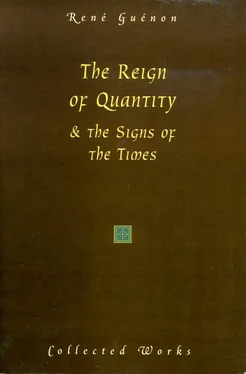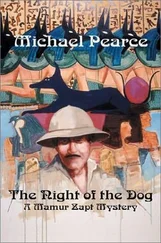A consequence of all this is that the solidification of the world appears to some extent to have a double meaning: considered in itself and from within the cycle, as being a consequence of a movement leading down toward quantity and ‘materiality’, it evidently has an ‘unfavorable’ significance, even a ‘sinister’ one, opposed to spirituality; but, in another aspect, it is nonetheless necessary in order to prepare, though it be in a manner that could be called ‘negative’, the ultimate fixation of the results of the cycle in the form of the ‘Heavenly Jerusalem’, where these results will at once become the germs of the possibilities of the future cycle. Nevertheless, it goes without saying that in the final fixation itself, and in order that it may indeed become a restoration of the ‘primordial state’, the immediate intervention of a transcendent principle is necessary, otherwise nothing could be saved and the ‘cosmos’ would simply evaporate into ‘chaos’. It is this intervention that produces the final ‘reversal’ already prefigured by the ‘transmutation’ of minerals in the ‘Heavenly Jerusalem’, and bringing about the reappearance of the ‘Terrestrial Paradise’ in the visible world, where there will thereafter be ‘a new heaven and a new earth’, since it will be the beginning of another Manvantara and of the existence of another humanity.
The ‘solidification’ of the world has yet other consequences not mentioned hitherto in the human and social order, for it engenders therein a state of affairs in which everything is counted, recorded, and regulated, and this is really only another kind of ‘mechanization’; it is only too easy nowadays to find typical instances anywhere, such as for example the mania for census-taking (which is of course directly connected with the importance attributed to statistics), [72] Much could be said about the prohibitions formulated in certain traditions against the taking of censuses otherwise than in exceptional cases, if it were to be stated that such operations, like all those of the ‘civil state’ as it is called, have among other inconveniences that of contributing to the cutting down of the length of human life (and this is anyhow in conformity with the progress of the cycle, especially in its later periods), but the statement would simply not be believed; nevertheless, in some countries the most ignorant peasants know very well, as a fact of ordinary experience, that if animals are counted too often far more of them die than if they are not counted; but in the eyes of moderns who call themselves ‘enlightened’ such things cannot be anything but ‘superstitions’.
and more generally, the endless multiplication of administrative interventions in all the circumstances of life. These interventions must naturally have the effect of ensuring the most complete uniformity possible between individuals, all the more so because it is almost a ‘principle’ of all modern administration to treat individuals as mere numerical units all exactly alike, that is, to act as if, by hypothesis, the ‘ideal’ of uniformity had already been realized, thus constraining all men to adjust themselves, so to speak, to the same ‘average’ level. In another respect, this ever more inordinate regulation has a highly paradoxical consequence, and it is this: the growing rapidity and ease of communication between the most distant countries, thanks to the inventions of modern industry, are matters of pride, yet at the same time every possible obstacle is put in the way of the freedom of these communications, to the extent that it is often practically impossible to get from one country to another, and in any case it has become much more difficult now than it was when no mechanical means of transport existed. This is another special aspect of ‘solidification’: in such a world there is no longer any room for nomadic peoples such as formerly survived in various circumstances, for these peoples gradually come to a point at which they no longer find in front of them any free space; and in addition to this, all possible means are used to cause them to adopt a sedentary life, [73] Two particularly significant examples may be cited here: the ‘Zionist’ projects as they affect the Jews, and the attempts recently made to fix the Bohemians in certain countries of Eastern Europe.
so that in this connection also the time seems not to be far distant when the ‘wheel will stop turning’; while in addition, within the sedentary life, the towns, representing something like the final degree of ‘fixation’, take on an overwhelming importance and tend more and more to absorb everything else; [74] It must be recalled in this connection that the ‘Heavenly Jerusalem’ itself is symbolically a town, which shows that in this case also there is reason to take account of a double meaning in ‘solidification’.
this is how it comes about that, toward the end of the cycle, Cain really and finally slays Abel.
Cain is represented in Biblical symbolism as being primarily a farmer and Abel as a stockmaster, thus they are the types of the two sorts of peoples who have existed since the origins of the present humanity, or at least since the earliest differentiation took place, namely that between the sedentary peoples, devoted to the cultivation of the soil, and the nomads, devoted to the raising of flocks and herds. [75] It may be added that, as Cain is said to be the elder, agriculture therefore appears to have some kind of anteriority, indeed Adam himself is represented as having had the function of ‘cultivating the garden’ in the period before the fall. This is also related more particularly to the vegetable symbolism in the representation of the beginning of the cycle (hence there was a symbolical and even an initiatic ‘agriculture’, the very same as that which Saturn was said by the Latins to have taught to the men of the ‘Golden Age’); but however that may be, all we have to consider here is the state of affairs symbolized by the opposition (which is at the same time a complementarism) between Cain and Abel, arising when the distinction between agricultural and pastoral peoples was already an established fact.
It must be emphasized that these two occupations are essential and primordial in the two human types; anything else is only accidental, derived, or superadded, and to speak of people as hunters or fishers for example, as modern ethnologists so often do, is either to mistake the accidental for the essential, or it is to restrict attention to more or less late cases of anomaly or degeneration, such as can be met with in certain savages (but the mainly commercial or industrial peoples of the modern West are by no means less abnormal, though in another way). [76] The names Iran and Turan have frequently been treated as if they were the names of races, but they really represented the sedentary and the nomadic peoples respectively; Iran or Airyana comes from the word arya (whence arya by extension), meaning ‘laborer’ (derived from the root ar , found again in the Latin arare , arator and also arvum , ‘field’); and the use of the word arya as a title of honor (for the superior castes) is consequently characteristic of the tradition of agricultural peoples.
Each of these two categories naturally had its own traditional law, different from that of the other, and adapted to its way of life and the nature of its occupations; this difference was particularly apparent in the sacrificial rites, hence the special mention made of the vegetable offerings of Cain and the animal offerings of Abel in the account given in Genesis. [77] On the very special importance of the sacrifice and of the rites connected with it in the different traditional forms, see Frithjof Schuon, ‘On Sacrifice’, in The Eye of the Heart (Bloomington, IN: World Wisdom Books, 1997), and A. K. Coomaraswamy, ‘ Ātmayajña : Self-Sacrifice’, in The Door in the Sky : Coomaraswamy on Myth and Meaning (Princeton: Princeton University Press, 1997), chap. 4.
As Biblical symbolism in particular is now being considered, it is as well to note at once in that connection that the Hebrew Torah belongs properly to the type of law appropriate to nomadic peoples. Hence the way in which the story of Cain and Abel is presented, for it would appear in a different light in the eyes of a sedentary people and would be susceptible of a different interpretation, although the aspects corresponding to the two points of view are of course both included in the profound meaning of the story; this is nothing more than an application of the double meaning of symbols, to which some allusion was made in connection with ‘solidification’, since this question, as will perhaps appear more clearly from what follows, is closely bound up with the symbolism of the murder of Abel by Cain. The special character of the Hebrew tradition is also responsible for the disapproval that is brought to bear on certain arts and certain trades specially appropriate to sedentary peoples, notably on everything connected with the construction of fixed dwellings; at any rate that was the state of affairs until the time when Israel actually ceased, at least for several centuries, to be nomadic, that is, up to the time of David and Solomon, and we know that it was even then necessary to resort to foreign workers for the building of the Temple in Jerusalem. [78] The fixation of the Hebrew people was essentially dependent on the existence of the Temple in Jerusalem; as soon as the Temple was destroyed nomadism reappeared in the special form of the ‘dispersion’.
Читать дальше











